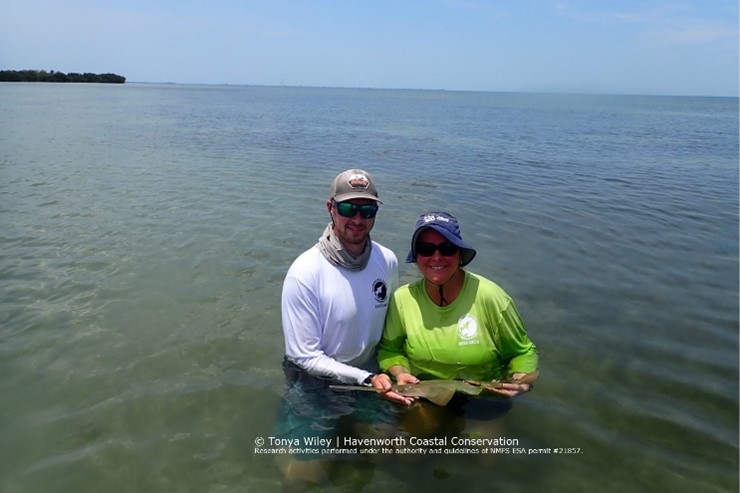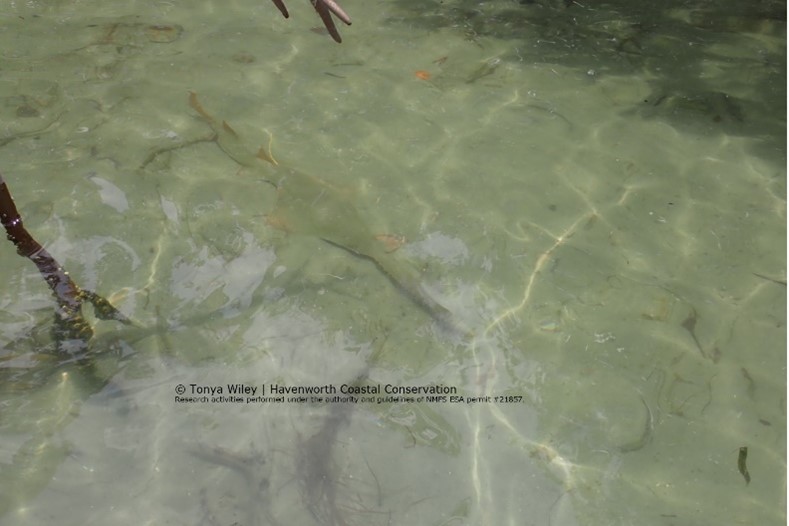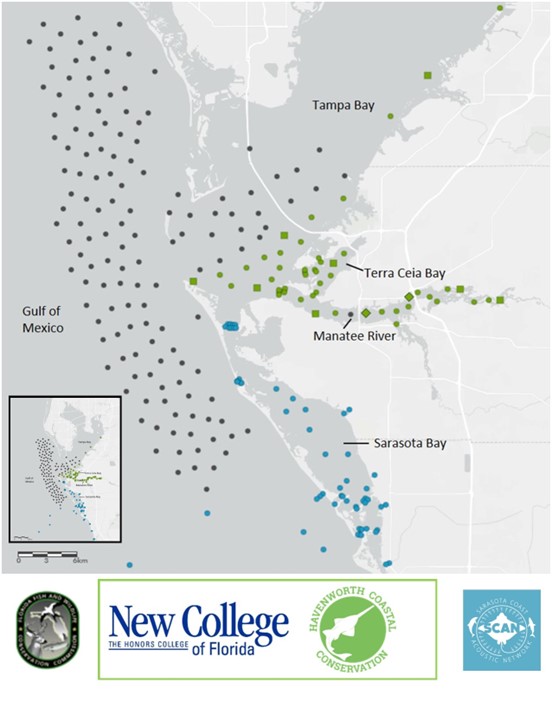
By Tonya Wiley
Two more sawfish have been tagged and released in Tampa Bay as part of a long-running initiative by the Havenworth Conservation Center (HCC).
The report came in on Tuesday, May 9: someone saw two tiny sawfish inside Tampa Bay (tiny for sawfish is about two feet since adults can reach up to 16 feet). Since reports of endangered sawfish on the Florida Gulf Coast north of Charlotte Harbor are rare, especially those of young ones, it was critical to respond quickly. On Thursday, scientists in the area around Rattlesnake Key in lower Tampa Bay successfully caught, tagged and released two male sawfish, estimated to be about a month old.
The two sawfish were found in about six inches of water on a sand flat near the mangrove shoreline. They were each implanted with a 4-year acoustic transmitter. Acoustic receiver listening stations placed in the Tampa Bay area and beyond will record the movements of these tagged sawfish, allowing scientists to study how long they remain in the area and how they use Tampa Bay habitats.
The receivers are part of an array of receivers in Tampa Bay, Terra Ceia Bay and Manatee River deployed to track the residency and movements of a variety of shark and ray species in collaboration with Jayne Gardiner at New College of Florida. Twice a year, divers locate the receivers and bring them to the boat for battery change and data download. The Tampa Bay array is part of a vast collaborative network of these listening stations in the southeastern United States through partners at UF/FWRI MERR Lab and the iTAG, FACT, and OTN programs.
A small skin sample collected from the dorsal fin of each sawfish will be processed by sawfish geneticist Kevin Feldheim at The Field Museum to determine if the two sawfish are siblings and to provide additional information about their relation to other sawfish in the U.S. research database.
This follows the 2021 catch and release of two juvenile sawfish off Redington Beach. However, those juveniles, identified as brothers by their DNA, have not been detected since their receivers were implanted. They were found in the high-energy surf of the Gulf of Mexico rather than the protected nursery habitat inside the bay like those born this year. That, coupled with the fact that they were exposed to red tide following the discharges from Piney Point, makes us very concerned about their survival.
Still, seeing sawfish north of their long-time habitats in the Everglades and Port Charlotte is cause for optimism about the species, which had been captured nearly to death before they were the first marine fish added to the Endangered Species List in 2003. “Following 20 years of protections under the Endangered Species Act, this is yet another sign that the smalltooth sawfish population may be expanding northward and reestablishing nursery areas in Tampa Bay,” said Adam Brame, the NOAA Fisheries U.S. sawfish recovery coordinaror.

It also highlights the importance of public outreach and citizen science. In both instances, the juveniles were identified by reports from citizens who saw the unusual fish and reported them. Anyone who catches or sees a sawfish anywhere in the United States can share that information with the U.S. Sawfish Recovery Team by visiting www.SawfishRecovery.org, calling 1-844-4SAWFISH, emailing sawfish@myfwc.com, or submitting the information through the FWC Reporter app.
The tagged sawfish are the latest success story for Havenworth Coastal Conservation (HCC), based in Palmetto, which was awarded a grant by the Disney Conservation Fund (DCF) to study the endangered smalltooth sawfish (Pristis pectinata) in the Tampa Bay region of Florida. The DCF funding supports two years of work (2022-2023) with two goals. First, use field research and public outreach and education to collect crucial information about the historical and current population of endangered smalltooth sawfish in the greater Tampa Bay area. Second, in collaboration with Shark Advocates International, use local, state, federal, and international policy initiatives to conserve and promote recovery of sawfish and their habitats in the United States.
Previous funding to HCC from the Save Our Seas Foundation allowed for three years (2019-2021) of initial investigation into the use of the Tampa Bay region by endangered sawfish and involved a lot of outreach and education to raise awareness of the species and solicit encounter reports from the public. The DCF funding has been critical to Havenworth continuing its sawfish research and outreach efforts in the greater Tampa Bay area.
Tonya Wiley is a fisheries biologist who conducted research on smalltooth sawfish for Mote Marine Laboratory and then established Havenworth Coastal Conservation in Palmetto to protect imperiled marine species through research, outreach and education and is leading the project to study sawfish in Tampa Bay. She is a member of the National Marine Fisheries Service’s Smalltooth Sawfish Recovery Implementation team, a multi-institutional panel of experts working to protect the remaining sawfish population in the US and prevent the species from going extinct. You can follow Havenworth Coastal Conservation on Facebook and Twitter for updates from the field. She also is available for presentations on sawfish to groups and organizations. She can be reached at Tonya@havenworth.org or 941-201-2685.
All research activities were performed under the authority and guidelines of NMFS ESA permit #21857.

